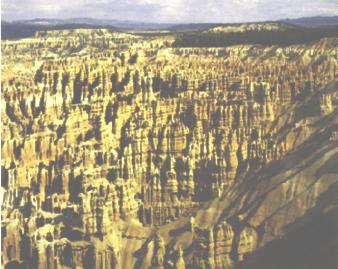
America's Canyonlands Tell of God's Handiwork
The cover of this month's issue of our journal is a picture taken deep in a place called Bryce Canyon. This past July our 2003 Summer Seminar was held in the area of Arizona and Utah where some of the most beautiful canyons in the world are located. The purpose of our summer seminar program is to train others to do what we are doing--showing that science and faith are compatible and that belief in God and in the Bible as His Word is logical and does not require putting one's brain in park. Sometimes these programs are classroom sessions running for a week, and sometimes they are in places where students can see and experience the evidence firsthand. In 2003, we had 101 people who signed on for five days of traveling by bus to the Petrified Forest, Meteor Crater, Grand Canyon, Bryce Canyon, Zion National Park, Canyonlands National Forest, Lake Powell, Oak Canyon, and all points in between. Alan Doty, our local expert geologist, and Dave Strong, our local expert on the geography and history of the area, were our co-teachers.
The Canyonlands area is the perfect place to see God's work in the early construction of the earth for man. When you leave Phoenix, you not only depart in 115° heat in July, but you also see the evidence of the condition of the early earth. The Phoenix area has a large number of the remains of ancient volcanoes, and the ground is littered with rocks that contain gas holes and evidence of flow. The creation of the earth involved great energy, and all evidence tells us that it was hot and that rocks were produced that would be the genesis material of all other materials on the planet. When volcanic rocks weather and are broken apart by heating and cooling and other processes that reduce their size, the first material to dissolve out is orthoclase which produces clay when it is redeposited. The iron in the material rusts to a red color to complement the pink orthoclase and what is ultimately left behind is quartz as sand. Before the trip was over, we saw massive amounts of sand, much of it beautifully colored by the red coloration from the dissolved materials, and much of it lithified into beautiful sandstone, most of it containing lines which show how it was deposited. Looking at the sand grains one can see that they are not all the same. Some are frosted, having been scratched by high-velocity collisions with other sand grains as they were blown about by the wind. Other sand grains are pure and glassy, indicating they were moved by water and never had the high velocity needed to frost their surfaces.
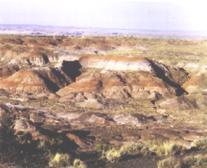 Periodically the sand was covered by mud or by deep water deposits of limestone
or dolomite in ancient lakes or seas. You frequently will see alternating
beds of sandstone, shale, limestone, and sometimes even gravel in the form
of conglomerate or breccia (rocks produced by cementing gravel into hard
rock). This layer cake or sandwich formation adds beauty and variation to
the rock and can be read historically as periods of time in which the weather
and surface conditions of the earth changed. What is especially beautiful
is when erosional forces work on this layered surface to shape it into forms
like those seen on our cover. Not all of the rocks weather and erode at
the same rate because the rocks have huge variations in hardness. One of
the reasons limestone is used so extensively as a building stone is that
it tends to get harder with age instead of breaking down as granite and sandstone
do. As a result, when water eroding an area gets down to limestone, the
erosion is slowed and nearly stopped. Places missing limestone (or where
fault lines or other disturbances have broken the limestone) will continue
to erode producing plateaus, buttes, spires, and columns like those seen
on page 3.
Periodically the sand was covered by mud or by deep water deposits of limestone
or dolomite in ancient lakes or seas. You frequently will see alternating
beds of sandstone, shale, limestone, and sometimes even gravel in the form
of conglomerate or breccia (rocks produced by cementing gravel into hard
rock). This layer cake or sandwich formation adds beauty and variation to
the rock and can be read historically as periods of time in which the weather
and surface conditions of the earth changed. What is especially beautiful
is when erosional forces work on this layered surface to shape it into forms
like those seen on our cover. Not all of the rocks weather and erode at
the same rate because the rocks have huge variations in hardness. One of
the reasons limestone is used so extensively as a building stone is that
it tends to get harder with age instead of breaking down as granite and sandstone
do. As a result, when water eroding an area gets down to limestone, the
erosion is slowed and nearly stopped. Places missing limestone (or where
fault lines or other disturbances have broken the limestone) will continue
to erode producing plateaus, buttes, spires, and columns like those seen
on page 3. All of what we have described so far is something we can still see going on as the earth continues to be changed by the forces of nature. We use our understanding of all of this to locate natural resources and to provide safety for our children and our cities. The majority of the evidence we see is very old and tells of God's patient preparation of the earth for man. "In the beginning, God created." does not tell us how God did the things that He did--just that He did it. I once had a student who decided to write the story of my life. She gathered all kinds of information about where I was born and about my childhood. When the paper was done, the student had 36 pages describing my life. The paper started by saying "John Clayton was born in Connecticut and grew up in the Midwest. He was educated at Indiana University and Notre Dame University, and he began teaching at Riley High School in 1959." The remainder of the story of my life was about my 41 years as a teacher. The Bible does very much the same thing. We are told that God created the cosmos and the earth. That takes one verse. The creation of man as a special being created in the image of God is developed in 31 verses. The rest of the Bible and its hundreds of pages deal with man's rejection of God and God's plan to redeem man and help him find his way back to God. Someone who wanted to know about my childhood from this student's paper would be disappointed. Someone wanting to know about the early history of planet Earth and all of the things God did and how He did it from Genesis 1 is also going to be disappointed.
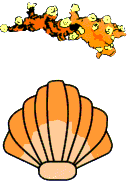 As we study all of these things, we begin to see the evidence of life on
the earth. In the rocks on the top of the Grand Canyon, we see fossils of
crinoids--a starfish-like animal that lives in the sea. We also see brachiopods,
clams, corals, and cephalopods like the nautilus--all oceangoing creatures.
In Petrified Forest, we see the fossil remains of ancient trees that are
like our ferns and evergreens. The record of life is sketchy as erosion
is not selective in what it removes from our view, but everything we see
is in agreement with what the Genesis account tells us. The oldest rocks
contain the records of plants being on the earth, and the sequence in which
those plants occur is biblically correct. "Let the earth bring forth grass
(deshe in Hebrew).herbs (eseb in Hebrew).and flowering trees
(peri in Hebrew)" is exactly what we see in the fossil remains. The
sequence is correct in every detail, but perhaps not in the volume that we
would like to see. The first animal life is sea life and is represented
by a wide variety of animal forms, and again this is the correct sequence
that the Bible gives: "let the waters bring forth abundantly the swarming
creatures" (Genesis 1:20). All of the things we see agree with what the
biblical record gives us, and the beauty and wisdom we see encourages and
elevates us.
As we study all of these things, we begin to see the evidence of life on
the earth. In the rocks on the top of the Grand Canyon, we see fossils of
crinoids--a starfish-like animal that lives in the sea. We also see brachiopods,
clams, corals, and cephalopods like the nautilus--all oceangoing creatures.
In Petrified Forest, we see the fossil remains of ancient trees that are
like our ferns and evergreens. The record of life is sketchy as erosion
is not selective in what it removes from our view, but everything we see
is in agreement with what the Genesis account tells us. The oldest rocks
contain the records of plants being on the earth, and the sequence in which
those plants occur is biblically correct. "Let the earth bring forth grass
(deshe in Hebrew).herbs (eseb in Hebrew).and flowering trees
(peri in Hebrew)" is exactly what we see in the fossil remains. The
sequence is correct in every detail, but perhaps not in the volume that we
would like to see. The first animal life is sea life and is represented
by a wide variety of animal forms, and again this is the correct sequence
that the Bible gives: "let the waters bring forth abundantly the swarming
creatures" (Genesis 1:20). All of the things we see agree with what the
biblical record gives us, and the beauty and wisdom we see encourages and
elevates us.
 What we do not see in the record recorded in the rocks, and what we do not
read in the biblical record is what seems to confuse people the most. Because
man-made religions want to establish a time frame to regulate what their
adherents do, the issue of time seems to be a problem to many people--atheists
and religionists alike. Attempts by the scientific community to assign dates
to the rocks we see and the events that are recorded in the rocks are always
based on assumptions, some of which are at best dubious. The assumption
that the processes we see in operation today have produced the canyonlands
that we are looking at is obviously flawed by what we see just east of Flagstaff
in Meteor Crater. As we look across this mile-wide dent in the earth's crust,
it is easy to visualize a chunk of rock from outer space hitting the earth
and modifying the surface in major ways. The bigger the rock that hit the
earth is, the more major the effect would be. Clearly astronomic events
can happen that could alter the earth in a way that would change our perception
of how long something might take. We also have to be reminded that the Bible
is not a clock and does not give us a time scale of when things happened
in the distant past. The time before the "creation week" and the time
after the week are not given and cannot be determined without making assumptions
that are not biblical.
What we do not see in the record recorded in the rocks, and what we do not
read in the biblical record is what seems to confuse people the most. Because
man-made religions want to establish a time frame to regulate what their
adherents do, the issue of time seems to be a problem to many people--atheists
and religionists alike. Attempts by the scientific community to assign dates
to the rocks we see and the events that are recorded in the rocks are always
based on assumptions, some of which are at best dubious. The assumption
that the processes we see in operation today have produced the canyonlands
that we are looking at is obviously flawed by what we see just east of Flagstaff
in Meteor Crater. As we look across this mile-wide dent in the earth's crust,
it is easy to visualize a chunk of rock from outer space hitting the earth
and modifying the surface in major ways. The bigger the rock that hit the
earth is, the more major the effect would be. Clearly astronomic events
can happen that could alter the earth in a way that would change our perception
of how long something might take. We also have to be reminded that the Bible
is not a clock and does not give us a time scale of when things happened
in the distant past. The time before the "creation week" and the time
after the week are not given and cannot be determined without making assumptions
that are not biblical.
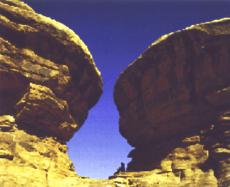 Another thing we do not see in the Grand Canyon is a complete record of
the history of life or of man. It has been estimated that 26 million different
forms of life have existed on this planet, and we see just a handful as we
look at the fossil record. Some of what we see we do not see living on the
earth today--including dinosaurs. The Hebrew words that describe life in
Genesis are words that any farm dweller in Palestine at the time of Moses
would have understood--cattle, sheep, fowl, fish, etc. Duckbill platypus,
amoeba, HIV virus, mole, echidna, seymouria, and the like are irrelevant
to the Bible's message and beyond the understanding of many of the people
it was intended for.
Another thing we do not see in the Grand Canyon is a complete record of
the history of life or of man. It has been estimated that 26 million different
forms of life have existed on this planet, and we see just a handful as we
look at the fossil record. Some of what we see we do not see living on the
earth today--including dinosaurs. The Hebrew words that describe life in
Genesis are words that any farm dweller in Palestine at the time of Moses
would have understood--cattle, sheep, fowl, fish, etc. Duckbill platypus,
amoeba, HIV virus, mole, echidna, seymouria, and the like are irrelevant
to the Bible's message and beyond the understanding of many of the people
it was intended for.
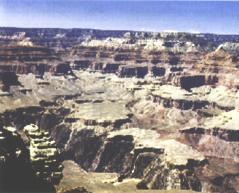 This discussion would not be complete without mentioning another thing that
is not seen in the canyonlands area--any evidence of the biblical
flood. Denominational creationists have tried to use the flood of Noah to
explain this area, and any young person with a background in earth science
can see the fallacy of such an assertion. We have already mentioned that
the sandstones seen in Zion National Park and in the Coconino sandstone in
the Grand Canyon are frosted by being banged into each other--something that
cannot happen under water. We have also mentioned that the limestone in
the various canyons is a chemically precipitated rock which is never produced
by a flood. When young people have experienced a flood they know that, in
order to clean up the mess from the flood, you are not chizeling limestone
off the piano; you are scraping mud out of the living room. Mud (which turns
into shale), sand (which turns into sandstone), and gravel (which turns into
conglomerate or breccia) are what you see in flood deposits. As you look
at the fossils in the canyons, you find that virtually all fossil deposits
consist of groups of the same animals. One outcrop we looked at had hundreds
of brachipods called eospirifer by paleontologists. One thousand feet deeper
into the Canyon, we found another outcrop containing no eospirifers, but
hundreds of brachiopods similar in size and density to the first called olenothyrus.
This is not what a flood would do--sorting animals so that similar groups
exist together in different layers. A flood makes total hash out of everything,
mixing, and mashing together the whole ecosystem.
This discussion would not be complete without mentioning another thing that
is not seen in the canyonlands area--any evidence of the biblical
flood. Denominational creationists have tried to use the flood of Noah to
explain this area, and any young person with a background in earth science
can see the fallacy of such an assertion. We have already mentioned that
the sandstones seen in Zion National Park and in the Coconino sandstone in
the Grand Canyon are frosted by being banged into each other--something that
cannot happen under water. We have also mentioned that the limestone in
the various canyons is a chemically precipitated rock which is never produced
by a flood. When young people have experienced a flood they know that, in
order to clean up the mess from the flood, you are not chizeling limestone
off the piano; you are scraping mud out of the living room. Mud (which turns
into shale), sand (which turns into sandstone), and gravel (which turns into
conglomerate or breccia) are what you see in flood deposits. As you look
at the fossils in the canyons, you find that virtually all fossil deposits
consist of groups of the same animals. One outcrop we looked at had hundreds
of brachipods called eospirifer by paleontologists. One thousand feet deeper
into the Canyon, we found another outcrop containing no eospirifers, but
hundreds of brachiopods similar in size and density to the first called olenothyrus.
This is not what a flood would do--sorting animals so that similar groups
exist together in different layers. A flood makes total hash out of everything,
mixing, and mashing together the whole ecosystem.

Science and faith are friends. It is distressing that, because people
have a denominational view that requires restrictions on God's methods and
processes, science and faith are presented as enemies. If the same God who
created the beautiful canyonlands areas gave us the historical account in
the Bible, the two understandings cannot conflict because they have the same
author. When humans construct a denominational dogma that is not in God's
Word, they inadvertently force God into a methodology that does not work.
God does not lie, misrepresent, or give man any excuse to not believe in
God or His Word. The canyonlands speak eloquently of the fact that the heavens
declare the glory of God and especially that the firmament showeth His handiwork.
Back to Contents Does God Exist?, NovDec03.